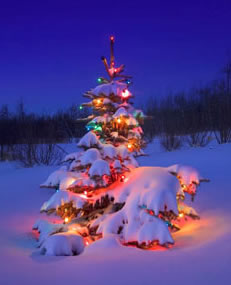When I was growing up, our Christmas tree emerged each year from a cardboard box in the attic. It looked like it was made of twisted coat hangers and toilet brushes. (The first artificial trees were actually made by a toilet brush manufacturer - Addis Brush Co.) The fact that it was fake had no impact on how wonderful the holiday was. My husband’s grandparents had an aluminum tree with a metal pole for a trunk. A revolving color wheel jazzed it up. (These trees are now collector’s items.) Ever since moving to Woodstock, our trees have come from a local, family-owned Christmas tree farm. We look forward to traipsing through the fields, using a handsaw to harvest our fresh tree, and hauling it home. But this article isn’t about whether an artificial, cut or living Christmas tree is best. It’s about making informed, thoughtful choices. Like most choices, it involves a tradeoff between pros and cons.
 |
ARTIFICIAL TREES typically cost $100 - $1200. PROS: An artificial tree is convenient. They don’t need water or shed needles, and can be left up for as long as you like. Newer trees have softer needles, are more realistic and easier to assemble – some even come pre-lit. They don’t violate fire codes for public buildings. If you forget to take an ornament off, it will be there next year. They don’t need to be disposed of until the end of their life, which might be about six years. CONS: An estimated 85% of fake trees are manufactured in factories in China, where working conditions are far from ideal. They are made from petroleum products, and petroleum is a nonrenewable resource. The majority are not recyclable, and will not decompose in a landfill any faster than other plastics. In one study, 33% of artificial trees tested contained lead in their needles. Not all are fire-resistant, and fires are usually caused by the lights anyway. Space is needed for storage during the off-season. They may accumulate dust and mold that trigger allergies. They are artificial, and often look it.
REAL CUT TREES cost about $35-65 in northeastern CT. Closer to Boston or New York, they run about $75. PROS: Selecting and cutting a live tree can be a family tradition. There are many sizes and varieties to choose from, some of which are fragrant. They are a renewable crop grown on a farm. 21,000 tree farmers nationwide help sustain the economy, providing about 100,000 jobs, while maintaining 500,000 acres of open space. Although they are cut, just like trees harvested to make holiday cards and this newspaper, one to three new seedlings are planted in each cut tree’s place to provide a steady supply for the future. According to the National Christmas Tree Association, 40-45 million Christmas Trees were planted in 2007. During the 7 to 15 years it takes to reach maturity, the trees emit oxygen and absorb carbon dioxide which helps the climate, and provide habitat for wildlife. They are biodegradable and recyclable (e.g., for mulch). CONS: Some varieties have prickly needles. Pesticides are typically used to keep them healthy until harvest. Some people are allergic to mold or pollen on trees. Cut trees can only be left up for a maximum of six weeks if kept watered after cutting. If they are not watered, or were cut months ago in Canada, they can pose a fire risk, and dropped needles can make a mess. At the end of the season, the tree needs to be transported somewhere for recycling, unless you can leave in the back of on your own property as wildlife shelter.
LIVING TREES cost on average $40-120, depending on size. Most pros and cons are the same as those for a cut tree. However, if you provide proper care and have room, you can plant the tree after the holidays. To increase the odds of survival, the tree must be in a container or have a moist (not frozen) root ball wrapped in burlap. You’ll need to dig the hole before the ground freezes, fill it with straw, and cover it with safety boards. Put the soil in a protected area like a garage where it won’t freeze. Keep the tree inside for no more than 5-10 days, away from heat sources (so it doesn’t dry up), and then move it to a protected area until you can plant it. Remove the burlap before planting and water it thoroughly. You could also get an indoor Norfolk Pine to use as your holiday tree.
Another option is to decorate an OUTDOOR LIVE EVERGREEN in your yard. It won’t brighten up the interior of your home, and some decorations are not weather-proof. On the flip side, the tree continues to live, the likelihood of a fire is lower, you can reuse it next year, and won’t end up with needles on the floor. So weigh the options, and after considering what works best for you AND the planet, have fun decorating, and enjoy the holidays. |

